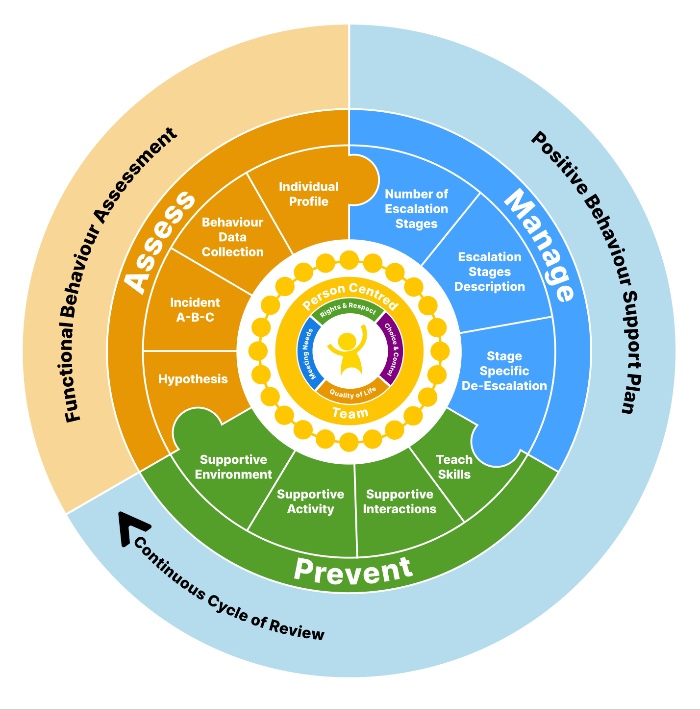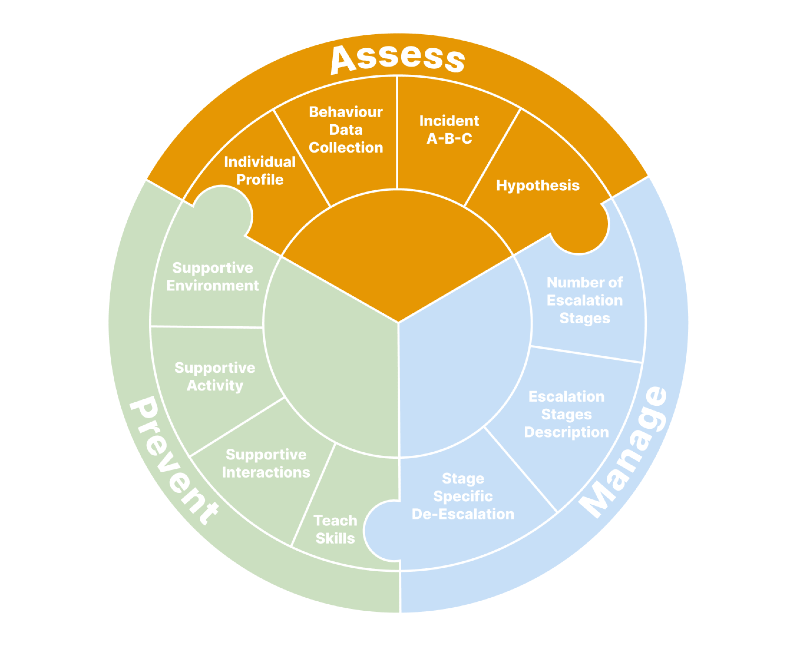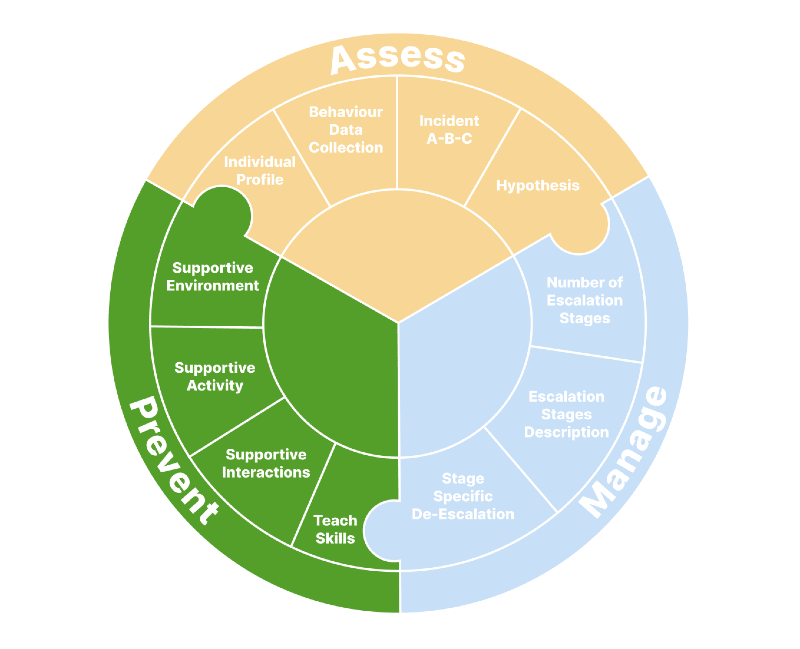On our blog there is collection of blog articles about Positive Behaviour Support such as 'What is Positive Behaviour Support' and 'School Wide Positive Behaviour Support Plan in 5 Easy Steps'.
Addressing Challenging Behaviour with Positive Behaviour Support
What is challenging behaviour?
Challenging behaviour includes internalised (e.g. being withdrawn, non compliant, inhibited) and/or externalised (e.g. aggressive, destructive, anti-social) behaviour that is perceived to be socially or culturally undesirable in a specific context by the person and/or the environment, and is of such an intensity, frequency or duration that it is detrimental, stressful or harmful for the person and/or the social environment (Wolkorte, van Houwelingen & Kroezen, 2019).
Simply ignoring the challenging emotional and behaviour responses does not make them disappear and, in many cases, the behaviours become more extreme and firmly entrenched the longer they remain unaddressed. They also have a range of negative impacts for the individual. They include:
Consequences in childhood
- Poorer family and peer relationships
- Lower levels of academic achievement
- Greater risk of school suspension/expulsion
- Fewer qualifications
- Social exclusion
Consequences in adulthood
- Poorer relationships with partners and own children
- Poorer physical and mental health
- Higher mortality rates
- Drug and alcohol abuse
- Links with offending behaviours
- Criminal activity
- Lower wages
- Poorer employment prospects
- Greater financial insecurity
Supporting individuals with challenging behaviours with insufficient support and guidance has a negative impact on the psychological, physical and emotional well-being of the person (e.g. parent, educator, professional). Hence, challenging behaviour affects everyone involved.

Examples of PBS in use
What is Positive Behaviour Support?
We also have a blog entitled 'What is Positive Behaviour Support' which looks at the different stages of the PBS model.
The Positive Behaviour Support (PBS) model is an evidenced-based implementation framework that is used to address the needs of the individual and the underlying causes of challenging behaviours. By utilising a person centered and strengths-based approach the PBS model aims to provide supports to enhance the quality of life for both the individual and those that support them.
Causes of Challenging Behaviour
PBS recognises that there is no single cause for challenging behaviour. It is a complex behaviour that is a product of the interaction between multiple factors contributing to its development and persistence, as explained by the bio-psycho-social model. This model considers how different biological, psychological and social factors interact and combine to influence behaviour:
- Biological factors include the individual’s age, gender, neurobiology, physiology and genetics (Schick, & Cierpka, 2016).
- Psychological factors include the individual’s cognition, emotion, self-esteem, behaviour, coping and social information processing skills (Reisinger, 2014).
- Social/environmental factors include parenting and family factors, educational environment factors; social environmental factors and community factors (Griffiths & Gardner, 2002; Meysamie et al., 2013).
To help identify and address these factors it is important to access various professionals: health (e.g. General practitioner/doctor, paediatrician), mental health (e.g. psychiatrist, psychologist and counsellor), allied health (e.g. occupational therapist, speech pathologist, NDIS exercise physiology, physiotherapist) and educational (e.g. learning specialists). To read about how the positive behaviour support plan can be used to support individuals with mental health please refer to the What is Mental Illness and How Does it Impact Behaviour? blog
In conjunction with identifying and addressing these factors PBS also emphasises importance of reflecting on the context. There are three main context-related factors that impact the individual and their behaviour: the environment, the activity and the interaction. These factors place different demands on the individual and when any of these demands outweigh the individual’s skills to cope with them, the individual engages in challenging behaviour. Resorting to exhibiting challenging behaviours may be the only way the individual has learnt how to respond to these demands, communicate their distress and get their message across.
The examples below showcase what happens when the demands placed on the individual outweigh their skills to cope with them.
Example 1
Zac is four-years-old and is playing with his red car. Zac is so engrossed he does not notice Kelly asking to play too. When Zac puts the car in the garage and reaches for a truck, Kelly takes the car.
Some of the skills needed to cope with this interaction include:
- Communication – Can Zac communicate to Kelly that he wants his toy back?
- Emotional regulation – Can Zac regulate his emotions and stay calm?
- Flexibility – Can Zac be flexible and play with the truck if the other Kelly does not return the car?
- Patience – Can Zac wait for the toy to be returned?
- Cooperation – Can Zac play with Kelly and take turns with the car and truck?
As Zac does not have the skills needed to cope, he resorts to biting Kelly, who drops the toy and runs away crying.
Example 2
Ethan is a fifteen-year-old teenager who has always enjoyed technology use. As soon as he would arrive home he would quickly do his chores and homework because it would be followed by technology use. His parents would set him a time limit and most of the time he would stop using the technology when the time was up. His parents realised that without scheduling outside activities he would stay on the technology all day. So during the week they booked Ethan into cricket, swimming and music classes. After those activities, no matter how late they arrived home, Ethan had to have some time on technology.
During the COVID-19 pandemic he had to do online schooling for eight months. Ethan struggled with online schooling and found the work extremely difficult. He kept falling behind in the weekly assigned tasks and it got to a point where he felt there was no point in even trying. Due to the social distancing laws Ethan could not leave the house which left him with a few options of things to do in the day. This resulted in Ethan spending an excessive amount of time on his iPad playing games, watching videos and surfing the internet. It almost got to a point that it was only during mealtimes, going to the toilet and showering that Ethan did not use technology. Over time his parents found it hard to get him to stop using it and move onto something else. Whenever they asked him to stop using his technology he would snap, yell, or become aggressive and refuse to stop. A battle would then ensue, but if his parents did not ask him to stop, he would continue playing all night without taking any breaks. Also, Ethan’s parents could see Ethan becoming withdrawn, less interactive and not willing to go outside the house.
When school re-opened Ethan refused to go back to school. The only way his parents managed to get him back to school was to give into his demands of purchasing better technology and certain games for his birthday. When Ethan returned to school, over the first couple of days he appeared to sit quietly at the back of the class working on his laptop. However, the IT department of the school reported to the teacher that he actually spent most of the day watching videos, playing games and looking at websites. The school worked with his parents to identify ways to limit his access to the laptop. If Ethan did not have access to his laptop within a class, he would often leave the class without permission within the first ten minutes. When in class he would distract other children and when told to do his work he would become easily upset, annoyed and revert to excessive technology use. During recess and lunch time he often would go to the library or the computer room to access technology. He also started skipping days when he couldn’t access the library or computer room.
When the team explored the underlying reasons for the behaviour they identified that Ethan had not been participating in online schooling. When he did return to school, he actually had regressed in previously learnt skills and found the classwork too advanced and difficult. As he had not been participating in the online sessions during the lockdown, he also had become isolated from his peers. When he returned to school, he did not have the same sense of belonging and connection. As Ethan had spent most of the time alone in his room engaging with technology, the return to the classroom where there were lots of people, noise, movement and clutter was creating sensory overwhelm and overload for him.
The example highlights that Ethan’s excessive technology use behaviour is not without purpose.
Example 3
Hazel has always found it hard to fit in at school. She is academically behind and has always had difficulty with making friends. Her dad runs his own business so works full time seven days a week. Her mother has severe depression so even though she is home she is not able to care for Hazel, give her attention, basic care, emotional warmth and time to get to know how she is going and what she needs help with. So, Hazel is left to her own devices for most of the time.
Hazel will often turn up to school without food. Before recess or lunch, she always asks the teacher if she can play basketball. The teacher explains to her that she can play basketball only if the area is supervised. If it isn’t supervised, she then has to join her peers. When her peers ask where her food is, she will often say she had a big breakfast and is going out for afternoon tea with her mum so isn’t hungry. If she thinks her peers are starting to doubt her story, she will on purpose have a fight with them and leave them.
Hazel’s teachers are frustrated because Hazel appears to be forgetful. She is always forgetting to bring in the signed excursion form or bring additional resources (e.g. notebooks, pens or craft material). Hazel is always borrowing resources from the teacher or her peers to complete her work. When her teachers ask her where the signed excursion form is, she keeps saying she forgot to ask her parents. She doesn’t want to tell the truth that by the time her dad gets home he is too tired to chat to her or go out and get something and her mum can easily anger so Hazel does not want to bother her.
Hazel in the last couple of months has had a growth spurt and has outgrown a lot of her clothes. She wears a jacket to cover up her undersized clothes even if it’s a hot day. On days where it is too hot and especially if there is assembly in the gym which is even hotter, Hazel finds it unbearable. Instead of taking off her jacket she will tell her teacher that she needs to go to the sick bay and can’t attend assembly.
Hazel’s teacher is extremely concerned about her and regularly asks her if everything is OK. Hazel says ‘Fine!’.
The example highlights that Hazel’s lying behaviour is not without purpose.
Hence, challenging behaviour does not happen in a vacuum. Identifying the reason/s is the key to finding a solution to understanding, managing and preventing the occurrence of challenging behaviour.
A Comprehensive PBS plan
PBS plan
A positive behaviour support plan involves utilising a person-centred and strength-based approach to address the needs of the individual, the underlying causes of challenging behaviours and overall quality of life. A positive behaviour support plan can be useful for children, adolescents and adults with emotional and behavioural difficulties, developmental delays, autism spectrum disorder, intellectual disability, learning disabilities, dementia, Huntington Disease and mental health disorders.

The positive behaviour support model provides a step-by-step framework for developing a behaviour support plan with the aim to maximise participation, quality of life, independence and development across multiple domains.
The framework involves three stages: Assess-Manage-Prevent.
Assess Stage

Assess Stage Aims
The Assess stage aims to identify:
- Individual's strengths, important elements of their life and systems of supports,
- Understand the person's needs, and
- Why the challenging behaviours are occurring.
Assess Stage Checklist:
- Individual’s profile – Gather information about the individual to create a comprehensive picture of the individual, their abilities and needs.
- Behaviour data collection forms – Record measurable details (e.g. frequency, intensity, duration) about the individual’s challenging behaviour.
- Functional Behaviour Analysis (FBA)- Systematically reflect on an incident by analysing the antecedents (what preceded the challenging behaviour), describing the challenging behaviour, and consequences (what happened after the challenging behaviour).
- Hypothesis – Determine the purpose (function) that the challenging behaviour served.
Manage Stage

Manage Stage Aims
The Manage Stage outlines how to effectively respond to the behaviours that occur before the challenging behaviour and after. Appropriate responses can help to safely defuse, redirect, and de-escalate the situation in the least disruptive manner.
Manage Stage Checklist:
- Escalation stages – Help those supporting the individual to recognise the number of stages the individual exhibits as their emotion rises (i.e. mild escalation, moderate escalation, extreme escalation, and recovery stage).
- Escalation profile– Help those supporting the individual to recognise what non-verbal and/or verbal behaviours are exhibited in the different escalation stages, where the challenging behaviour occurs in the escalation and how long it can last.
- De-escalation plan – Help those supporting the individual with guidelines on how to immediately respond when the behaviour occurs, safely defuse, and de-escalate the situation in the least disruptive manner.
Prevent Stage

Prevent Stage Aims
This stage aims to prevent the occurrence of challenging behaviours by minimising or avoiding the triggers that cause it, create a context that is responsive to the indivdiual's needs, teach the individual alternative behaviours and improves their quality of life.
Prevent Stage plan
The plan details strategies to minimise or avoid the triggers that contribute to the challenging behaviours by providing the individual with:
- Supportive environments – Tailoring environment-related aspects to minimise or avoid triggers that set off challenging behaviour.
- Supportive activities – Tailoring activity-related aspects to minimise or avoid triggers that set off challenging behaviour.
- Supportive interactions – Tailoring interaction aspects to minimise or avoid triggers that set off challenging behaviour, and;
- Teaching the individual – Teaching the individual positive ways of communicating their messages and managing their emotions and behaviours.
Conclusion
As parents, teachers, support staff and professionals, we can work as a team to support an individual with emotional and behavioural difficulties.
Each member of the team can bring their own unique knowledge and perspective and the combination of all of the team members' ideas will help develop a comprehensive behaviour support plan.
When everyone works together in a unified manner, the team can effectively support each other and guide the individual through the transformative journey to a better future. With persistence, patience and perseverance we can successfully build the individual’s capability and capacity to develop positive ways of behaving and managing their emotions.
If you would like help to dive deeper into the challenges that you are currently facing get in touch for behaviour coaching.
References
- Griffiths, D. M., & Gardner, W. I. (2002). The integrated biopsychosocial approach to challenging behaviours. In D. M. Griffiths, C. Stavrakaki, & J. Summers (Eds.), Dual diagnosis: An introduction to the mental health needs of persons with developmental disabilities (pp. 81–114). Sudbury, ON: Habilitative Mental Health Resource Network.
- Meysamie, A., Ghalehtaki, R., Ghazanfari, A., Daneshvarfard, M & Mohammadi, M. R. 2013. Prevalence and Associated Factors of Physical, Verbal and Relational Aggression among Iranian Preschoolers. Iran Journal of Psychiatry, 8, 138–144.
- Reisinger, L. (2014). Using a Bio-Psycho-Social Approach for Students With Severe Challenging Behaviours. LEARNing Landscapes, 7, 259–270.
- Schick, A. & Cierpka, M. (2016). Risk factors and prevention of aggressive behaviour in children and adolescents. Journal for Educational Research Online, 8, 90–109.
- Wolkorte, R., van Houwelingen, I. & Kroezen, M. (2019). Challenging behaviours: Views and preferences of people with intellectual disabilities. Journal of Applied Research in Intellectual Disabilities: 32, 1421-1427.
Resources
Which resources are right for you?
Apps
Based on the Taking CHARGE of Rainbow of Emotions Workbook this app helps children of all ages develop emotional regulation skills. The app guides the child to firstly, identify and express their emotion in appropriate ways. Then the child is guided to use emotional management tool/s from the CHARGE tool kit to manage their emotions in a healthy way.
The acronym CHARGE stands for the different categories of emotional management tools – Chat tools, Helpful thinking tools, Amusement tools, Relaxation tools, Good routine tools and Exercise tools.
Behaviour Help App - Using the evidence-based approach of Positive Behaviour Support (PBS), the Behaviour Help web-based app allows people supporting individuals with emotional and behavioural difficulties to complete a Functional Behaviour Analysis and put together a comprehensive Behaviour Support Plan (BSP). The BSP can then be used by everyone interacting with the individual to manage and prevent challenging behaviours and ultimately improve their lives, and the lives of those who support them.
Books
If you want to learn more about emotional and behavioural difficulties then we have a great range of books you can read on your Kindle or order from Amazon.
Coaching
Personalised and practical one to one help tailored specifically to your family.
Online Courses
Access these online courses anytime online to learn about a range of diagnoses, practical skills and strategies to help develop the individual’s emotional regulation skills. Also learn to utilise the positive behaviour support framework to address anxiety, aggression, ADHD, ASD and ODD.
Therapy
Personalised and practical behaviour therapy tailored specifically to your family.
Webinars
Webinars discuss a range of practical strategies to guide your child learn positive ways of behaving and managing their emotions.
Workshops
Attend our practical and interactive workshops to learn about a range of diagnoses, practical skills and strategies to help develop the individual’s emotions, behaviours, social and communication skills in your learning environment.

